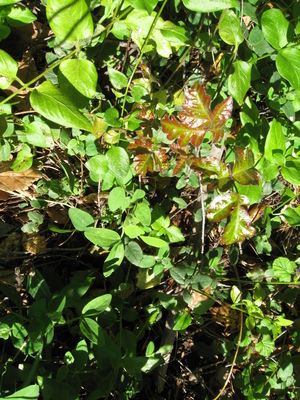Are you new to an area that has poison oak?
Poison Oak (Toxiconfrendon diversilobum) is an invasive plant that grows wild in Santa Cruz county and other northern California areas. When you are new to this area and come from places where poison oak does not grow it is imperative that you are able to identify it to prevent the ‘urushiol’ in the plant oils from getting on your skin. Knowledge is your best tool to prevent an irritating rash.
Poison oak can grow as a small seedling, runner, vine or shrubby bush. Vines can be several years old, several inches in diameter and climb half way up a Redwood tree. Seeds spread by birds and all these different forms of growth are why it is so pervasive and continues to spread through its climatic ranges.
The common name ‘poison oak’ comes from the fact that the leaves can look similar to the leaves of young oak plants growing in the forests. Oak leaves are also shiny, similar in shape and can be red in the spring and fall. The main difference is that oak leaves grow alternating on the stem of the plant and not in threes.
You will also find wild blackberries and poison oak thriving in the same conditions and they often intertwine with each other. The older tougher leaves of poison oak can look similar to blackberry leaves. One quick way to see the difference between them is that blackberry stems have thorns and poison oak does not have thorns. Blackberry leaves also grow in threes and can have reddish tones. The old adage used for identifying poison oak, “if it comes in threes let it be”, is useful and will also help you avoid the thorns of the blackberries. The two different plants are more easily distinguished later in the season when there are flowers and fruits on them.
Most of the available information on poison oak mentions that the leaves are red in the fall. This is true but don’t be fooled by this in the spring. The first new leaves coming out on the plants can be red too. After months or weeks of being dormant in the winter, without any leaves, the stems, vines, runners and remnants of last year’s poison oak will suddenly appear everywhere and the new leaves can be very red. The sudden first leaf growth in the spring may be the ones that catch you off guard, especially if you don’t know where the patches were growing last year.
Twenty years ago it was more difficult to find good pictures to identify Poison Oak. Now we have digital cameras and access to the Internet so it is much easier for anyone to find information and good pictures of Poison Oak for identification.
A picture is worth a thousand words but being vigilant and learning to identify Poison Oak where it is growing is worth a thousand # %* words if you don’t recognize it and come down with an irritating rash.



